How to Find and Adopt a Successful Marketing Team Structure
In today's fast-paced and highly competitive business environment, having a high-performing marketing team structure can make all the difference in achieving business success and innovation.
A well-structured marketing team can help drive brand awareness, increase customer engagement, and, ultimately, drive revenue growth.
Gartner's research highlights the significant and essential role that marketing plays in creating and advancing innovation. As many as 91% of marketers indicate that their team is actively involved in their organization's innovation strategy.
However, building and managing a successful marketing team is not an easy task. It requires a deep understanding of the industry, the target audience, and the marketing landscape.
In this article, we will explore the key steps to structure a high-performing marketing team, including the structure, roles and responsibilities, the skillsets required, and the best practices for managing and motivating your team.
How are marketing teams structured?
Typically, marketing teams are structured around product or function, but alternative structures such as geography, market segment, or channels exist.
Here are some examples:
-
Functional Structure: In a functional structure, the marketing team is divided into different departments or functions, such as advertising, public relations, social media, and market research. Each team is responsible for a specific aspect of marketing and is headed by a department lead who reports to the marketing director.
-
Product-Based Structure: Each team is responsible for marketing a specific product or service, and they work closely with the product development team to ensure that their marketing strategy aligns with the product's features and benefits.
-
Geographic Structure: The marketing team is organized by region or location. The team markets the organization's products or services within a specific geographic area.
-
Hybrid Structure: A company may have a functional structure for corporate marketing but a product-based structure for its consumer product line.
Your marketing team structure varies depending on the size and nature of your organization and the company's strategy, marketing goals, and objectives.
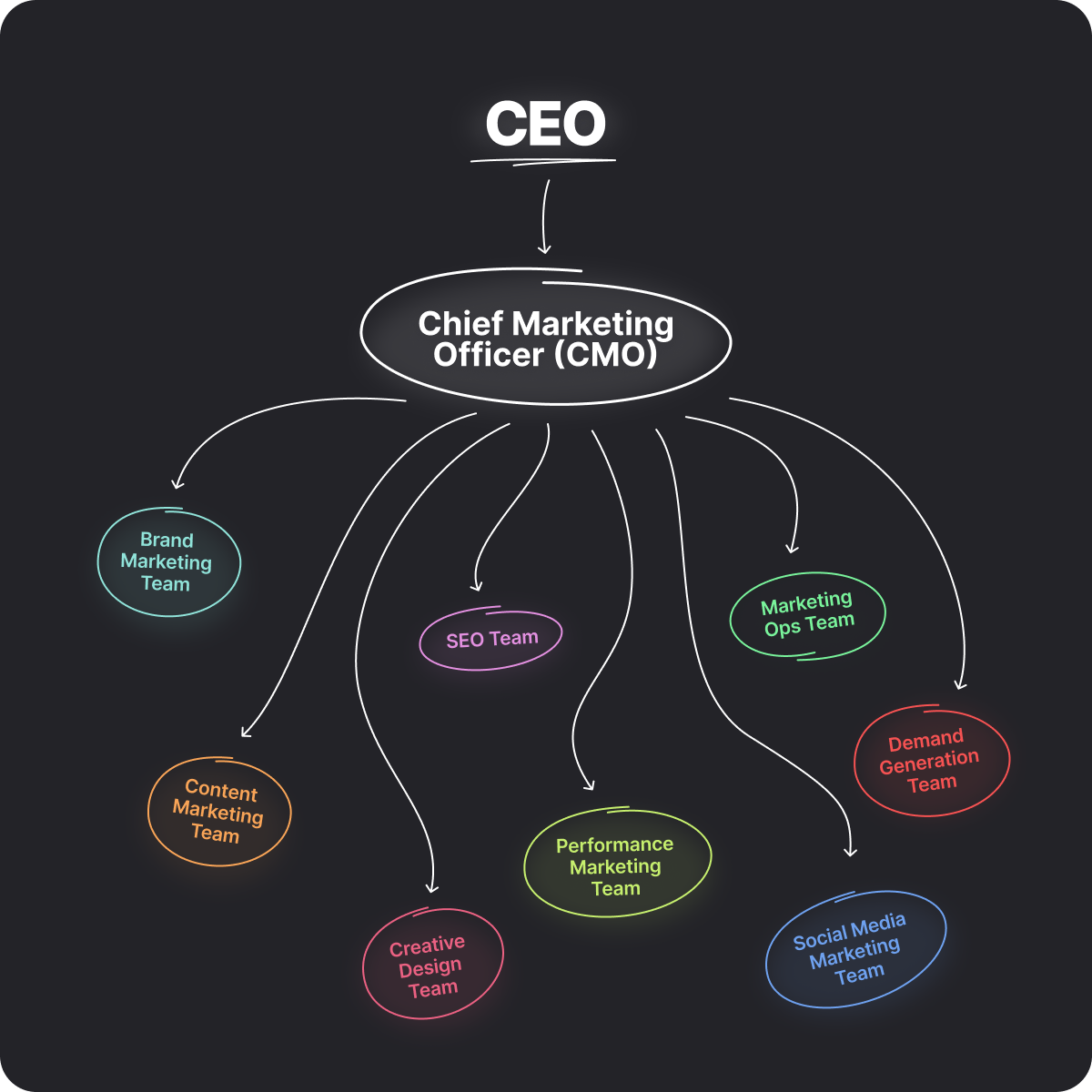
Let’s take it back for a sec. The main goal of your overall marketing department is to convert audiences into customers. In 2023, marketers are still focusing heavily on lead generation, with 53% spending half or more of their budget on lead gen efforts.
Structuring and hiring for your marketing department can be challenging as the industry is ever-changing. The marketing teams should work independently but also cohesively with other marketers. You should also consider looking for team members that can play multiple roles or work in hybrid teams.
Let’s look at some of the different teams within the marketing department:
Brand marketing team
Branding marketing is key in driving awareness of a company's product or service. Effective brand marketing can differentiate a brand from its competitors and increase customer engagement and loyalty.
The ultimate goal of brand marketing is to create a solid and recognizable brand that resonates with customers and inspires trust, loyalty, and advocacy.
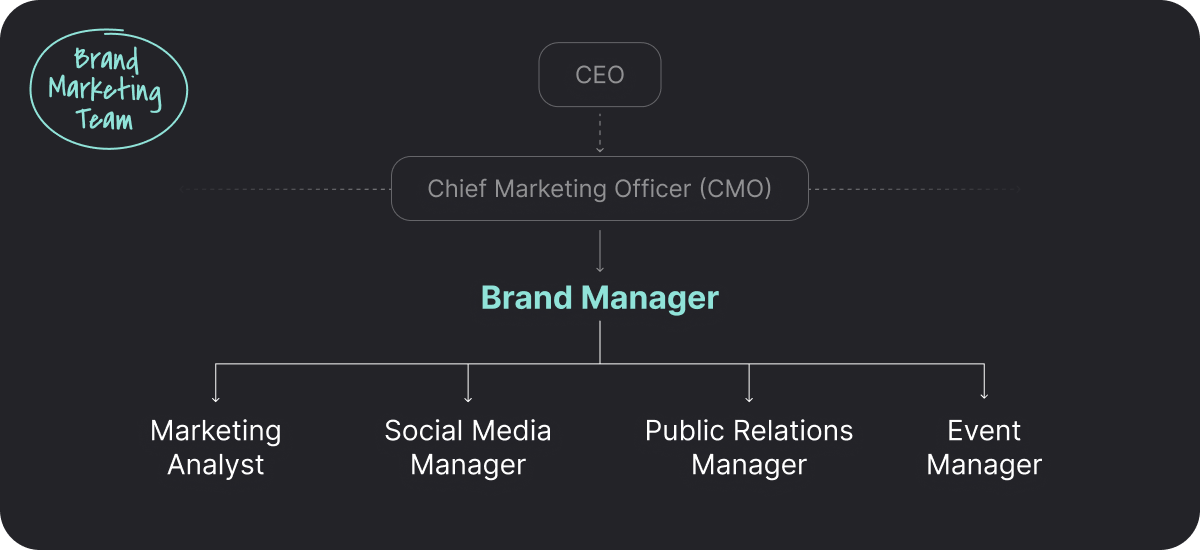
The roles and responsibilities of the brand marketing team
These roles may vary depending on the size and structure of the team, but they all play a critical role in developing and executing successful brand marketing strategies.
-
Brand Manager: Responsible for developing and implementing the overall brand strategy.
-
Marketing Analyst: Collects and analyzes brand performance and market trends data. They provide insights and recommendations to the brand manager and other team members to help guide marketing decisions.
-
Social Media Manager: Develops the brand content strategy and manages the brand's social media accounts, creating content and engaging with the brand's followers.
-
Public Relations Manager: The public relations manager manages the brand's reputation and builds relationships with journalists, influencers, and other media outlets. They also oversee the development and execution of PR campaigns.
-
Event Manager: Plans events that promote the brand and engage with customers. They work closely with other team members to ensure that events are aligned with the brand's messaging and values.
Successful brand marketers possess creative and analytical skills, excellent communication and collaboration abilities, and a deep understanding of marketing concepts and strategies.
They should be adaptable to changing market conditions, able to create compelling stories and content, and continuously evaluate and adjust campaigns.
Content marketing team
These words by Bill Gates are from some years ago but still carry weight today: content is king.
To achieve success in marketing, it is essential to deliver content that caters to customers' specific needs. This is where the content marketing team comes into play, as they take charge of all content creation aspects, such as blog articles, videos, podcasts, white papers, and more. Essentially, this team leads the way in everything related to content creation.
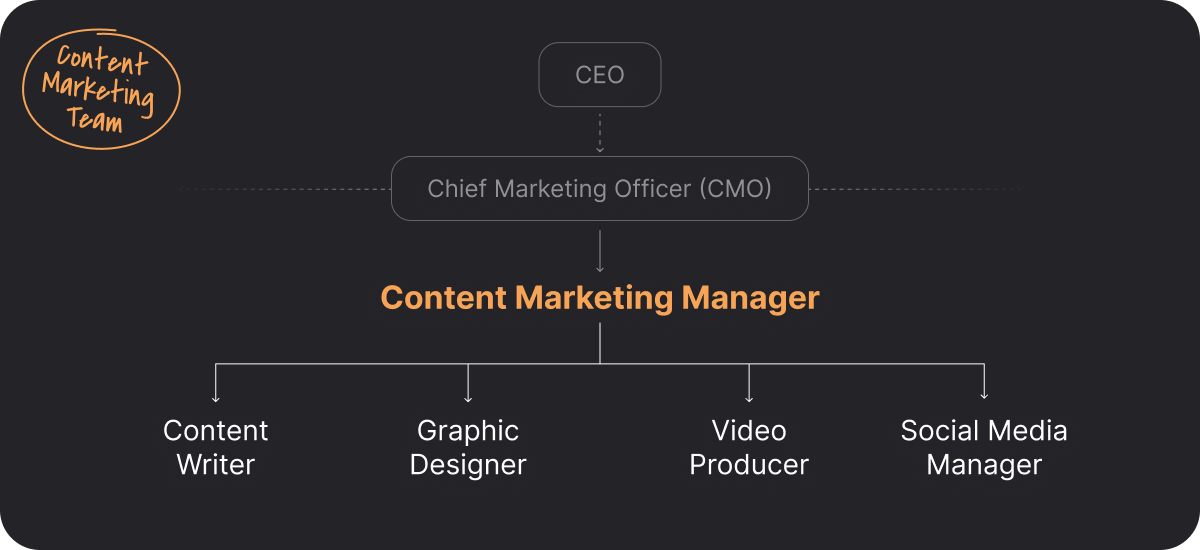
The roles and responsibilities of the content marketing team
Content marketers are equally strategic and creative as they focus on valuable and consistent content to attract the audience. There might be some overlap between the content marketing team members and other roles.
-
Content Strategist or Content Marketing Manager: Develops the content marketing strategy that aligns with the brand's overall marketing goals and tracks success. They analyze the target audience, identify content themes, set goals and KPIs, and develop the content calendar.
-
Content Writer: Responsible for creating written content such as blog articles, white papers, case studies, and social media posts. They ensure the content is engaging, informative, and aligned with the brand's messaging and values.
-
Graphic Designer: Creates visually appealing and engaging content, such as infographics, images, and videos. They work with the content team to ensure that the visual content is aligned with the brand's visual identity.
-
Video Producer: Develops high-quality video content, including product demos, explainer videos, interviews, and social media videos. They manage the video production process, from scriptwriting and storyboarding to filming and editing.
-
Social Media Manager: Manages the brand's social media presence and creates engaging and shareable social media content.
Content creators will need writing, editing, organization, and problem-solving skills. Since this job is all about the output and is very visual, the team will have to define the brand story and present it internally to ensure the company is aligned with the message.
SEO team
The ultimate goal of the efforts of the SEO team is to rank your company’s page in search engines. The SEO team implements on-page, off-page, and technical SEO strategies.
Leadership teams might ask them to chip in on business decisions from time to time. If a brand changes names, you need to know how hard it is to rank for that keyword on Google.
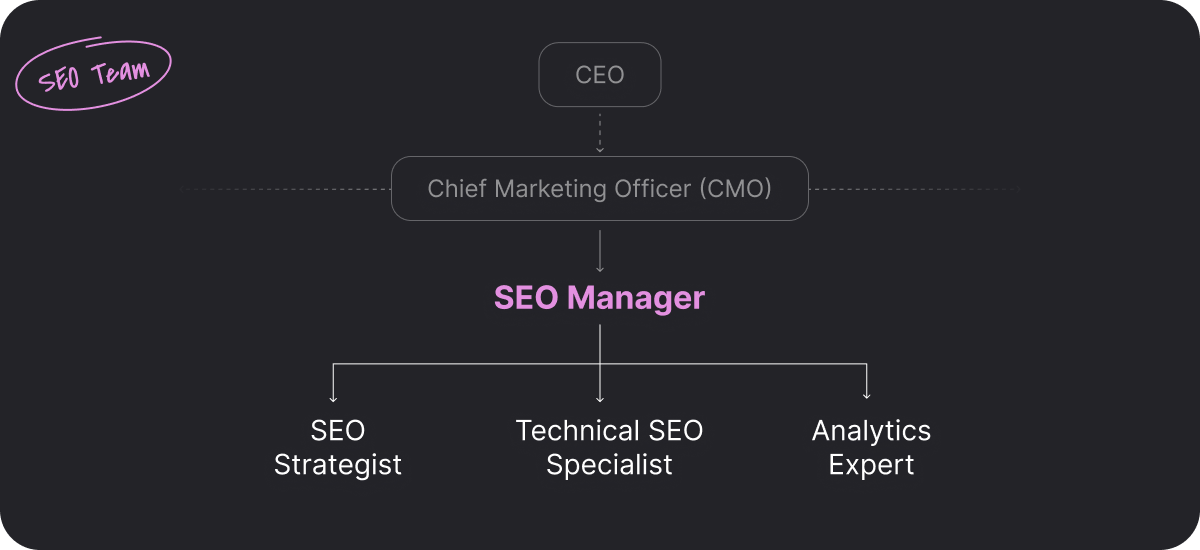
The roles and responsibilities of the SEO team
The recommended roles for your SEO team depend on the size of your company, whether you want this to be in-house or external.
Here are some suggested positions:
-
SEO Manager: Oversees the entire SEO team and manages the team's workflow, sets goals and KPIs, and ensures that the SEO strategy is executed effectively.
-
SEO Strategist: The SEO strategist is responsible for developing the overall SEO strategy that aligns with the company's goals. They analyze the competition and identify target keywords.
-
Technical SEO Specialist: Responsible for identifying and fixing technical issues that might affect the website's search engine rankings. They optimize the website's structure, ensure that it is mobile-friendly and improve page speed.
-
Analytics Expert: Monitors and analyzes the website's performance using analytics tools. They track SEO metrics such as traffic, rankings, and conversions.
To achieve solid ranking search results, all team members require various skills on top of their specialism, such as data analysis, keyword research, writing, editing, proofreading, and problem-solving. Additionally, proficiency in using and interpreting data from analytics software is essential.
Web or graphic design team
Any business needs a website and high-quality marketing materials to stand out. This team can be embedded in other departments or work as a standalone team.
The brand, content, product, and performance marketing teams collaborate with the graphic design team to produce eye-catching content assets, websites, and landing pages.
The roles and responsibilities of the web or graphic design team
Not all graphic design teams have all these roles, and some may have additional roles depending on the project's specific needs.
-
Creative Director: Oversees the design team and ensures the design work aligns with the brand's vision and objectives.
-
Graphic Designer: Creates the visual elements for mediums such as print and digital media.
-
Web Designer: Specializes in creating user interface designs and website layouts.
-
UX/UI Designer: Focuses on the user experience and user interface design of digital products.
-
Motion Graphics Designer: Creates animated graphics and visual effects for videos and websites.
Structure your marketing team with creatives with strong knowledge and passion for their field. Since this team will be responsible for all things visual and web, hire people that are also good collaborators, especially if this team works hybrid with other marketing specialists.
Performance marketing team
Keeping track of the performance of each digital marketing element is a job in itself. Performance marketing teams focus on driving measurable results by tracking the advertising spend and linking that to the outcomes of a specific strategy.
The roles and responsibilities of the performance marketing team
The team usually works hybrid with other creative teams who can supply assets, ad copy, and landing pages. Common roles include:
-
Performance Marketing Manager: Oversees the performance marketing team and sets the strategy and objectives.
-
PPC Specialist: Manages pay-per-click (PPC) advertising campaigns on platforms like Google Ads, Bing Ads, or social media platforms.
-
Data Analyst: Collects, analyzes, and interprets data to monitor campaign performance, identify opportunities for optimization, and develop insights for decision-making.
-
Conversion Rate Optimization Specialist: Focuses on improving the conversion rate of landing pages and websites through A/B testing, user research, and data analysis.
The performance marketing team has a dedicated focus but has to work with different departments to do their job successfully. The interpretation and visualization of the data are essential to get all company levels on board.
Also read: Mastering the Art of Digital Marketing Project Management
Social media marketing team
Social media marketing is essential for brands, as it helps them establish a connection with their audience.
The social media marketing team collaborates closely with the content, product, and graphic design teams to transform content into formats that resonate with the target audience.
However, especially in smaller companies, the social media marketing team is also responsible for customer service and engagement. They will communicate with (potential) customers through social media, comment sections, or blogs. Understanding the tone of voice and branding guidelines of the company is key.
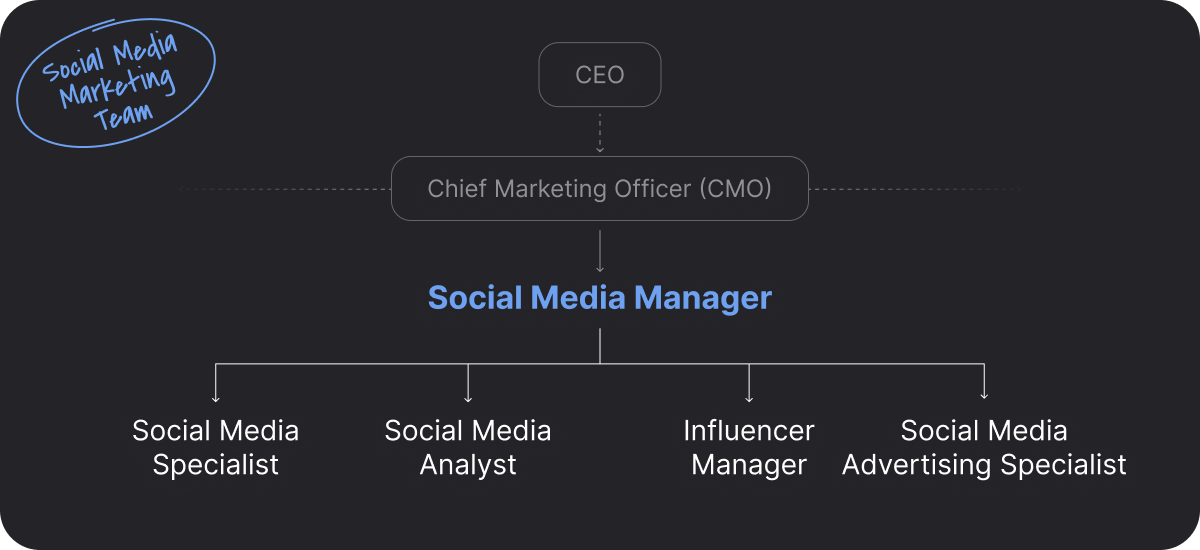
The roles and responsibilities of the social media marketing team
Creating, posting, engaging, liking, and optimizing; there’s a lot that goes into a social media post. Roles include:
-
Social Media Manager: Leads and oversees the social media marketing team and sets the strategy and objectives.
-
Social Media Specialist: Manages and executes daily social media operations, including content creation, publishing, and community management.
-
Social Media Analyst: Analyzes social media metrics, such as engagement, impressions, and conversions, and provides insights for optimization.
-
Influencer Manager: Manages relationships with social media influencers, negotiates partnerships, and develops influencer marketing campaigns.
-
Social Media Advertising Specialist: Develops and manages social media advertising campaigns, targeting specific audiences and optimizing for specific objectives such as conversions or engagement.
Your social media marketing team members should all have a working knowledge of creating, scheduling, and measuring social content performance. Graphic design and analytical skills will help with content production and measuring success.
Demand generation team
All markets are crowded with brands wanting the customers’ attention. Demand generation teams do more than raise brand awareness. They drive awareness and interest all the way throughout the complete sales cycle.
This involves using marketing and sales data, automation, and testing various strategies to build relationships and earn trust.
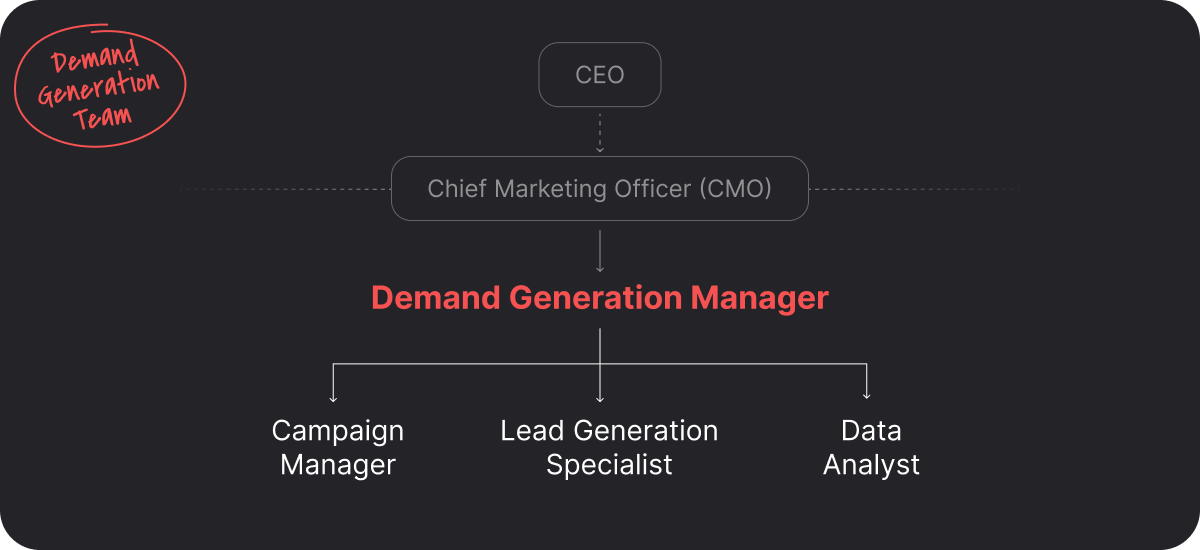
The roles and responsibilities of the demand generation team
Demand generation is a very specific vertical of the marketing world. However, demand generation specialists combine various skills and are usually embedded within marketing teams.
-
Demand Generation Manager: Oversees the demand generation team and sets the strategy and objectives for the team.
-
Campaign Manager: A professional who plans, executes, and manages demand generation campaigns across various channels, such as email, search, social media, and events.
-
Lead Generation Specialist: Focuses on creating and executing strategies for generating new leads, such as through targeted outreach, content marketing, and SEO.
-
Data Analyst: Interprets data to monitor campaign performance, identify opportunities for optimization, and develop insights for decision-making.
In addition to being fluent in marketing software, demand generation teams should be able to incorporate lessons from those metrics and pass on relevant information to other teams.
Product marketing team
This team is essential because they will sit between departments and are responsible for communicating the features and benefits of your product.
They hold a great deal of information about the product-market fit as a big responsibility is detailed customer research. On top of that, the product marketing team will handle product launch campaigns.
The roles and responsibilities of the product marketing team
Key roles to have on this team include:
-
Product Marketing Specialist: A professional who creates and executes product marketing campaigns, including messaging, positioning, and go-to-market strategies.
-
Market Researcher: Conducts market research and competitive analysis to inform product marketing strategies and make data-driven decisions.
-
Sales Enablement Specialist: Develops and delivers training, resources, and tools for the sales team to effectively sell and promote the product.
-
Product Marketing Analyst: Analyzes and measures the impact of product marketing campaigns and initiatives, providing insights for optimization and future development roadmaps.
This team connects your brand to the customer. Product marketers must be good planners with attention to detail, as they will organize campaigns for your products or services.
Marketing Ops team
You need fuel to run highly successful campaigns – and we’re not talking lunch. Marketing operations involve the people and processes that power the overall marketing strategy, such as project planning, organizing alignment meetings, and technology operations.
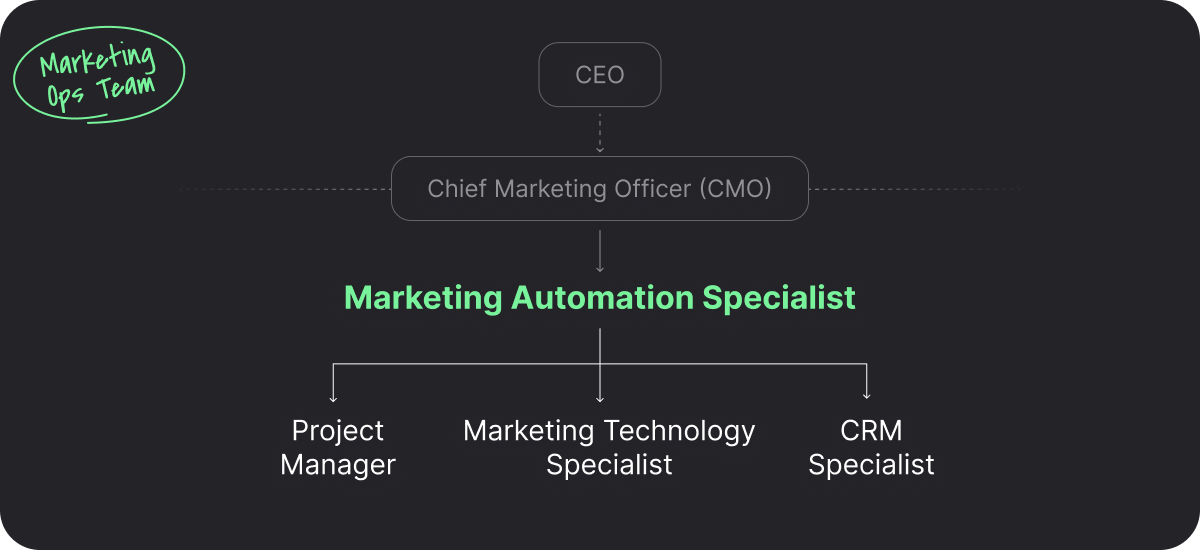
The roles and responsibilities of the marketing ops team
Since the marketing ops team is the backbone of the overall marketing operation, this team includes a variety of skill sets:
-
Marketing Automation Specialist: A professional who manages and maintains the marketing automation software and other technology tools used in marketing campaigns.
-
Project Manager: Coordinates cross-functional teams to deliver marketing projects and initiatives on time and within budget.
-
Marketing Technology Specialist: Researches and implements new marketing technologies and tools to improve marketing operations and efficiency.
-
CRM Specialist: Manages the company's CRM system, ensuring that it is properly integrated with other marketing tools and supporting the sales and marketing teams.
This team will be the go-to for software questions, juggling requests from internal and external stakeholders and keeping the C-level up to date and on board. Marketing ops specialists have to think quickly on their feet and be on top of the latest trends.
The 4 biggest challenges (and solutions) for marketing teams
Marketing is so fast-paced that it can be challenging to identify how you'll facilitate stronger growth in 2023. Let’s reflect on the biggest challenges marketing teams face this year.
1. Keeping up with 2023 trends
Trends are in constant flux; regardless of where you direct your attention, they are ever-evolving. Open your social media feeds, and you’ll see a new TikTok trend or Instagram hype daily.
In marketing, there’s always this nagging feeling your audience may become disinterested and shift their attention to a more captivating brand.
Cut out the noise and consider the industries and trends most relevant to your brand or the ones your target audience is actively engaged with. Creating an overview with the accounts to watch helps give you a structured overview of the channels and accounts to check out daily.
2. Hiring the right people
This year might be the year of layoffs and budget cuts. In-house marketing is becoming a priority for numerous companies, increasing the need for exceptional marketing professionals.
Teamwork makes the dream work – but how do you go about changes within the team? The hiring process can take several months, from locating the ideal candidate and assessing them for the necessary skills and company culture fit.
Narrow down the exact needs, wants, and wishes for each role and develop a profile to simplify the sourcing process.
3. Ever-changing marketing plans
Lesson learned: Unprecedented events pose new challenges. The pandemic taught us that original plans do not always work out how we want them to, and we must pivot from our original ideas.
As a marketer, you want to be one step ahead of the current situation. Asking yourself and your team: ‘what if?’ helps you build out scenarios and pivot faster when the world changes again.
4. Securing the marketing project budget
Acquiring and maintaining a (larger) marketing budget can be challenging, particularly for smaller organizations with limited or inflexible marketing expenses.
However, obtaining more funds for your team may not be as complicated as it seems.
Prove your worth. The success of your marketing team’s efforts significantly contributes to securing larger budgets.
In-house marketing is a long-term strategy, have your forecasts and goals ready for when management asks for an update. Here’s how you set marketing OKRs in 10 steps.
Related: 8 Steps To Track Project Budgets

Structuring the best marketing team for your company
Ultimately, your marketing team determines how fortunate your projects and campaigns will be. Following this framework will help you set up your marketing team for success.
1. Establish your marketing budget
Your marketing project budget outlines the required funds to complete the work. When presenting the budget, the goal is to win internal stakeholder approval to move forward with the necessary funds.
The budget proposal document ensures everyone’s alignment and is essential to instill financial transparency within your organization and team. Your proposal must be concise and efficient and justify the budget.
Want a head start on your marketing budget proposal? We’ve got you covered with our project budget template.
2. Create clear timelines
Your marketing campaign management plans might not fit into a timeline, but it’s important that marketing campaign managers create a schedule for the marketing team to follow.
What this schedule will look like depends on your team and goals. For social media teams, you’ll want to decide your channels, formats, and posting frequency and organize your workflows around that.
3. Coordinate and facilitate communication
Every team is different, and every team member has different communication styles. Before your project starts, create a master document outlining how and how often communication will occur. Include a list of people receiving updates and decide on the communication channels. Establish a general timeline for project communication, as your schedule will help set your team’s expectations.
4. Set up reporting
Coordinating your marketing team is one thing, but ensuring it’s a successful effort is an entirely separate undertaking. Your marketing projects should have an end date so you can measure their performance.
Marketing leads might want to measure performance through employee productivity if the project stays within budget. Rodeo Drive can help you monitor these metrics.
Tip: Consider time blocking to prioritize tasks and optimize productivity.
5. Use the right tools
If your campaigns have several moving parts, you want to keep your team organized while keeping tabs on everyone’s progress.
Utilizing project management software tailored to marketing will save time while working on projects. You might need to onboard new staff while the project runs. Assess your team's needs and processes before choosing a marketing project management tool.
Power your marketing team with Rodeo Drive
Marketing projects involve a lot of moving pieces. The power lies in leading marketing teams with transparency and simplicity with a bit of help from a software tool.
Look for a solution beyond the basic planning features that allow you to manage everything from estimating, budgeting, resource management, and reporting.
Rodeo Drive’s features
Because marketers tend to focus more on the creative rather than the administrative side of things, you’ll want a project management tool that’s built for creatives – like Rodeo Drive.
-
Project budget management: All projects in Rodeo Drive start with a detailed, phase-based project budget, which you’ll customize to meet your needs.
-
Time tracking: Every time entry is connected to a budgeted activity, allowing your marketing spending to be easily tracked.
-
Reporting: Access insights on project profitability, employee productivity, and time registration.
-
Assign tasks based on availability: Eliminate confusion by breaking down the project into manageable phases and tasks and plan out which days they should be worked on.
Why not see if Rodeo Drive is the right software for managing your marketing campaigns? Try for free today.







